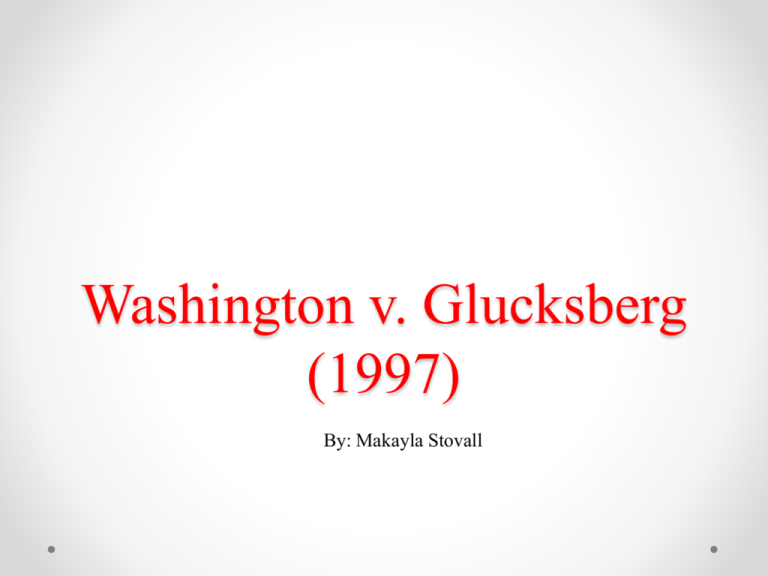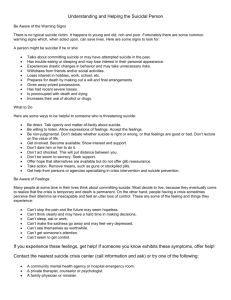Washington Powerpoint
advertisement

Washington v. Glucksberg (1997) By: Makayla Stovall Case Washington State Washington state was challenged for its ban on physicianassisted suicide. “By upholding the statue and denying mentally competent, terminally ill patients a constitutional right to hasten their death through lethal doses of selfadministered, doctor proscribed medication”. Glucksberg Dr. Harold Glucksberg Plaintiff Washington physician Believed it was unconstitutional to deny a patient close to death the right to end their life with a doctor’s help. Uses Due Process Clause as a defense claimed that assisted suicide was a liberty interest protected by the Due Process Clause Due Process Clause “Prevents state and local government officials from depriving persons of life, liberty or property without legislative authorization”. Original Case January 1994- lawsuit was filed January 1997- The lawsuit was taken to the “U.S. District Court for Western District of Washington” Glucksberg argued that “the Washington statue prohibiting assisted suicide was forged at the common law, tempered by centuries of legal traditions, and ratified by recent legislative action” He argued that physician- attempted suicide is supported by organizations of health care professionals who care for the sick and dying regularly. Glucksberg biggest argument was that Washington’s ban was unconstitutional and unfair. District Court Ruling The district court “ruled the statue unconstitutional, on the ground that it violated the liberty interest protected by the Due Process Clause of the fifth and fourteenth amendments to the U.S. Constitution” Court of Appeals The case was appealed to the U.S. Court of Appeals for the Ninth Circuit. A panel of judges “2-1 decision that reversed the district court’s ruling and reinstated the Washington statue” “The court of appeals emphasized that no right to assisted suicide has ever been recognized by a court of final jurisdiction anywhere in the United States” Appeals Court cont. The Due Process Clause caused problems for the appeals court. Therefore the case was brought into court again and reheard. Case was heard by 11 judges. In an 8-3 decision, the appellate court stated “the Constitution encompasses a due process liberty interest in controlling the time and manner of one’s death” The original decision to reinstate the Washington statue was then reversed. The District Court’s ruling was reinforced. Supreme Court Chief Justice William H. Rehnquist proved that the Due Process Clause did not actually protect the right to commit suicide with another’s assistance. It is not a law unless it is deeply rooted in the nation’s legal history “Because the Court found the asserted right to physician-assisted suicide to be contrary to U.S. history, tradition, and practice, it concluded that it was not a fundamental right” Supreme Court cont. On June 26, 1997, the Court made its decision. unanimous vote of 9 votes for Washington and 0 votes against Chief Justice Rehnquist wrote the majority decision “the patient is allowed to die by natural causes when life-sustaining treatment is withdrawn” “if the death is intentionally inflicted by the joint effort of doctor and patient, the cause of death is not the underlying illness” Concurring Opinions Justices Sandra Day O’Connor Stephen Breyer David H. Souter A Few of Their Ideas O’Connor-the states remain free to establish a right to physician-assisted suicide or to otherwise strike a proper balance between the interests of terminally ill patients and the interests of society Breyer-“suggested that the right to die should be renamed “the right-todie with dignity” Dissenting Opinion The unanimous decision caused few dissenting opinions. John Paul Stevens Dissenting opinion agreed with O’Connor’s in the fact that “the need for further national debate on the propriety of physician-assisted suicide” The Effects • “In 2008 Washington state voters approved Washington Death with Dignity Act” • “est. guidelines for using the services of a physician to terminate one's life” • I agree and disagree with the results of the case. • I believe a person should be able to die if there are suffering unbearable pain. However, not if family is just trying to sign off a person’s life. Works Cited • • • • "Washington. "Washington v Glucksberg." Encyclopedia.com. HighBeam Research, 01 Jan. 2005. Web. 23 Nov. 2013 "Washington v. Glucksberg." Wikipedia. Wikimedia Foundation, 11 Aug. 2013. Web. 23 Nov. 2013 "Google." Google. N.p., n.d. Web. 23 Nov. 2013. "Washington v. Glucksberg, 117 S.Ct. 2258, 138 L.Ed.2d 772 (1997)." Washington v. Glucksberg, 117 S.Ct. 2258, 138 L.Ed.2d 772 (1997). Cornell University Law School, 08 Jan. 1997. Web. 23 Nov. 2013. Pictures Hyperlinked








